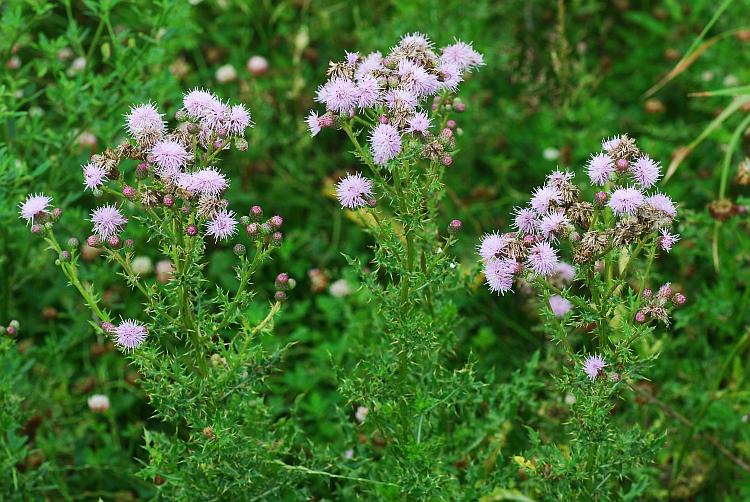Cirsium arvense (L.) Scop.
Canada Thistle

Introduced
CC = *
CW = 3
MOC = 9
© SRTurner
Cirsium arvense (L.) Scop.Canada Thistle | |
 |
Introduced CC = * CW = 3 MOC = 9 |
© SRTurner |
|
Family - Asteraceae/Cardueae Habit - Perennial forb, imperfectly dioecious (some plants with only pistillate florets, others with a combination of staminate and perfect florets), suckering and forming potentially large, clonal colonies from widely creeping, deep-set, black roots. Stems - Erect, to 1.5 m, usually several-branched toward the tip, glabrous or with patches of cobwebby hairs (especially when young), hollow, striate, lacking spiny-margined wings.
Leaves - Basal and alternate. Basal leaves usually absent at flowering, 8-30 cm long, 2-6 cm wide, narrowly oblong-lanceolate to elliptic or ovate, tapered at the base, sharply pointed at the tip, shallowly to deeply pinnately lobed, the lobes spiny and sometimes irregularly toothed, the upper surface appearing green, glabrous to thinly pubescent with woolly or cobwebby hairs, the undersurface appearing green or more commonly gray, glabrous to densely pubescent with woolly or felty hairs. Stem leaves well developed nearly to the inflorescence, mostly 2-20 cm long, slightly expanded and sometimes minutely decurrent at the base, often somewhat narrower than but otherwise like the basal leaves.
Inflorescence - Loose clusters or solitary heads at branch tips. Branches of inflorescence (peduncles) pubescent with cobwebby hairs.
Heads - Involucre 10-20 mm long, as long as or slightly longer than wide, urn-shaped, glabrous or more commonly somewhat cobwebby-hairy. Involucral bracts imbricate, appressed, the lower and median bracts tapered to an appressed or ascending, nonspiny tip, this often with a minute, sharp point, green or purplish-tinged, usually also somewhat sticky along the midrib. Bract tips usually slightly spreading. Outer bracts with sparse to moderate arachnoid pubescence. Receptacle flat.
Ray flowers - Absent. Disk flowers - Corollas 12-20 mm long (those of staminate florets slightly shorter than those of pistillate florets), pale pinkish to lavender-purple, rarely white, the 5 lobes 3-5 mm long, thickened at apex with small protuberance. Pappus of dense plumose bristles, 12-25 mm long at flowering (longer in pistillate than in staminate florets), white or grayish-tinged.
Fruits - Achenes to 2.5-4.0 mm long, glabrous, terete to weakly 4-angled.
Flowering - June - October. Habitat - Crop fields, disturbed areas, roadsides, railroads. Origin - Native to Eurasia. Lookalikes - Other thistles, e.g. Cirsium discolor, C. vulgare, etc. Other info. - This is a nasty, noxious weed throughout much of the U.S., particularly in states to our north and west. Fortunately, it is still relatively uncommon in Missouri, having been collected in only nine counties thus far. In addition to its general thistle-like appearance, the plant is recognized by usually having numerous, smallish flowering heads. The stems are unwinged, the leaf undersides are greenish rather than whitened, and the involucral bracts are pointed but not spiny. The plant is quite aggressive, and due to its deep and extensive rhizomes is very difficult to eradicate.
Photographs taken in Spencer, WI., 8-6-04 (DETenaglia), also along a crop field near Fremont, Newaygo County, MI, 7-2-2014 (SRTurner). |